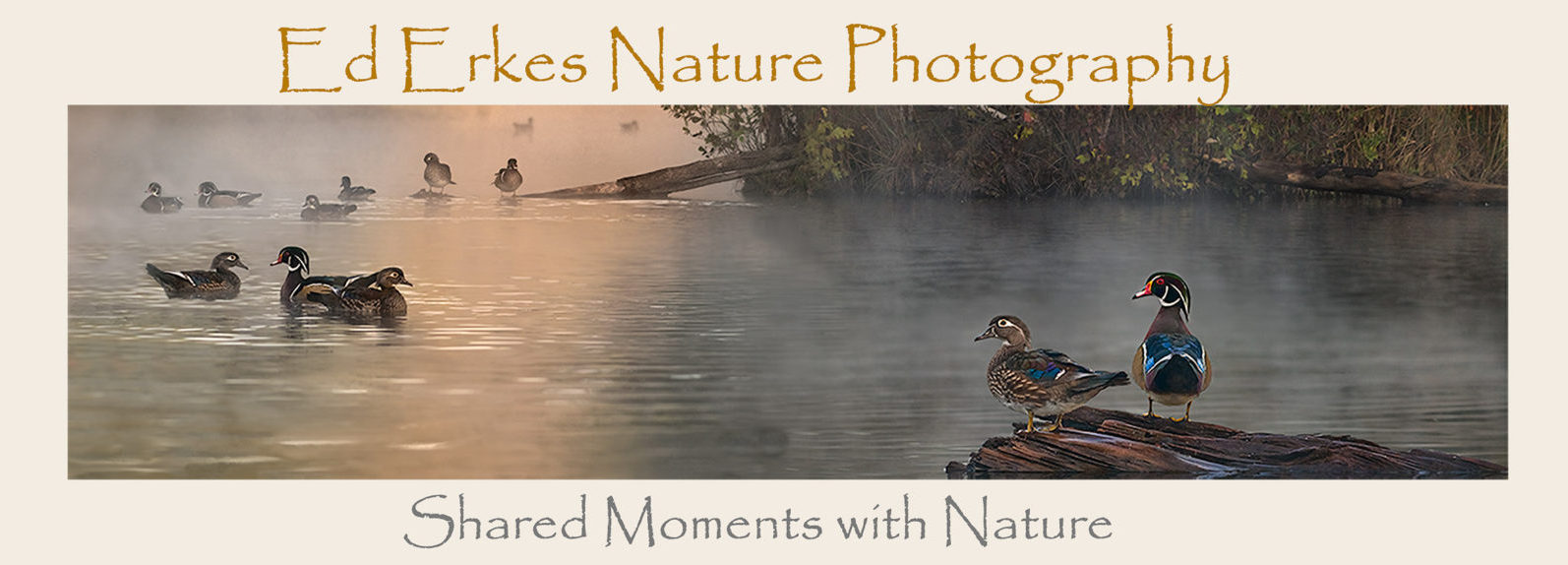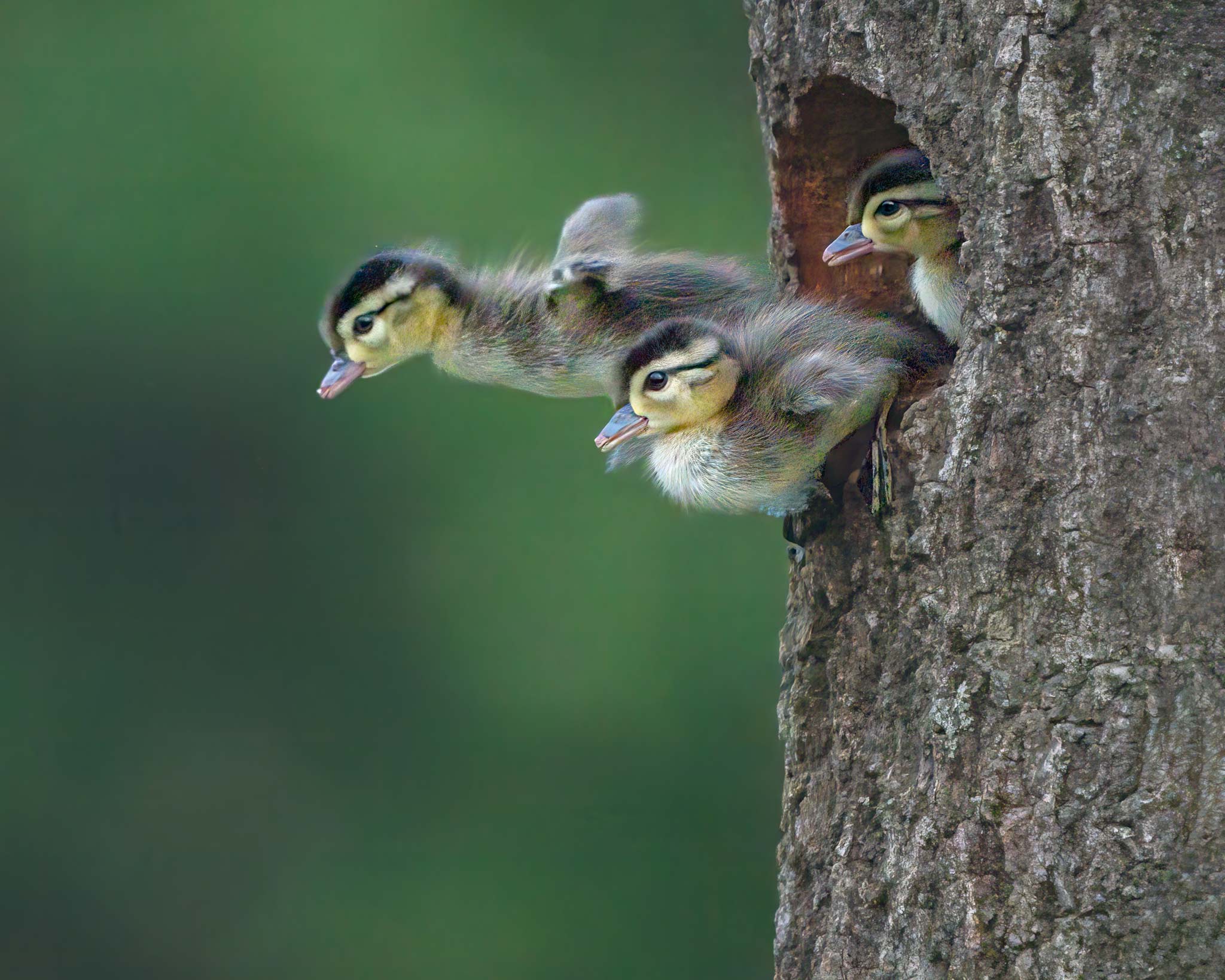Wood Ducks are one of the few North American ducks that nest in tree cavities or nest boxes. The ducklings leave the nest the day after hatching. Leaping from the nest entrance with their tiny, ineffective wings extended, they fall to the water or ground unharmed and begin their life journeys. It is undoubtedly one of the most exciting and memorable wood duck behaviors to witness. I call the event “Jump Day.”
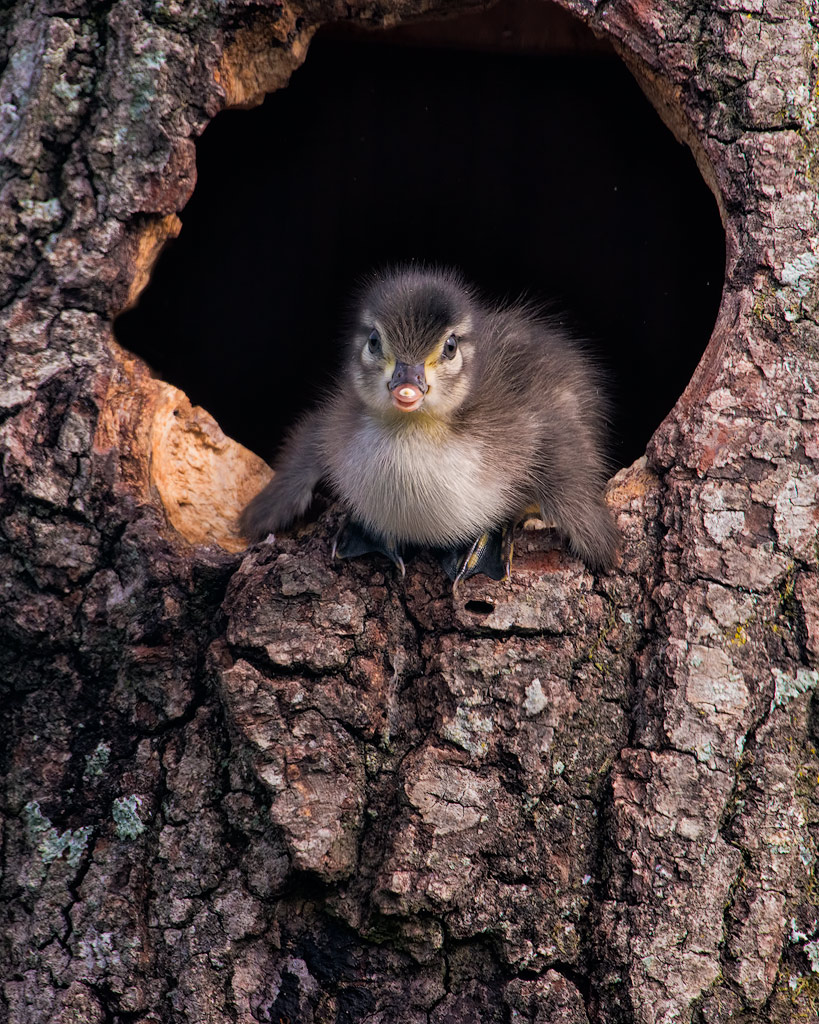
I’ve attached natural log fronts to the nest boxes on my pond.
Leonard Lee Rue III described the event as “one of my greatest personal moments witnessing nature.” These are not just idle words. Leonard Lee Rue is quite possibly the most accomplished wildlife photographer/naturalist of the last 60 years. A full time writer/photographer since 1965, he has over 1800 magazine covers to his credit. In the heyday of magazine publishing in the 1970s, his images appeared in at least 50 publications a month and he once had cover images on five national magazines in the same month. As a naturalist he is considered an expert on deer, red foxes, beaver and other species. He has authored 31 books on nature and was awarded an Honorary Doctorate of Science by Colorado State University for his works on White-tailed Deer.
So considering Rue’s vast experience as a naturalist and a photographer, his enthusiastic description of “jump day” should not be taken lightly. Rue witnessed the the event in 2004 and published his experience in an article for the online photography magazine Vivid Light entitled “Success at Last”. He writes, “It has taken me 58 years …. to get video footage and photos of a sight I had never seen, that most folks will never see.” Although the online magazine is no longer published, his article is still currently available online here. It is well worth reading.
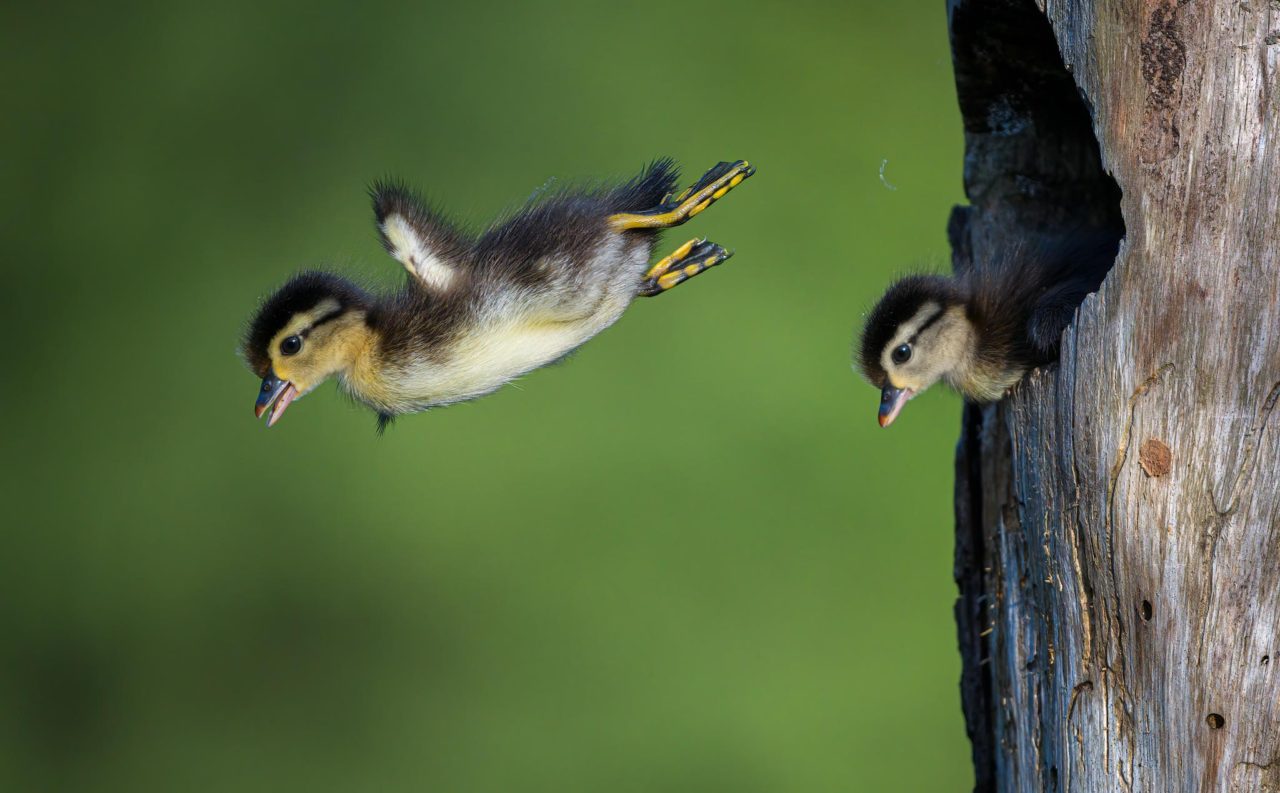
Rue’s article indirectly illustrates one advantage an amateur photographer may have over a professional. Leonard Rue had several opportunities to photograph “jump day” over 58 years before finally succeeding in 2004, but his efforts were limited by the numerous other projects and subjects that he was actively pursuing as a professional photographer. An amateur photographer, unburdened by the pressure to produce income from his work, is free to concentrate his photography on subjects of particular interest and availability. By concentrating a great deal of my photographic efforts on wood ducks over the last 11 years (first at a nature reserve where I volunteered to help monitor 33 wood duck nest boxes and then later at my backyard pond and its seven nest boxes) I have been able to witness and photograph 15 jump days (July 2023 Update: 19 jump days witnessed).
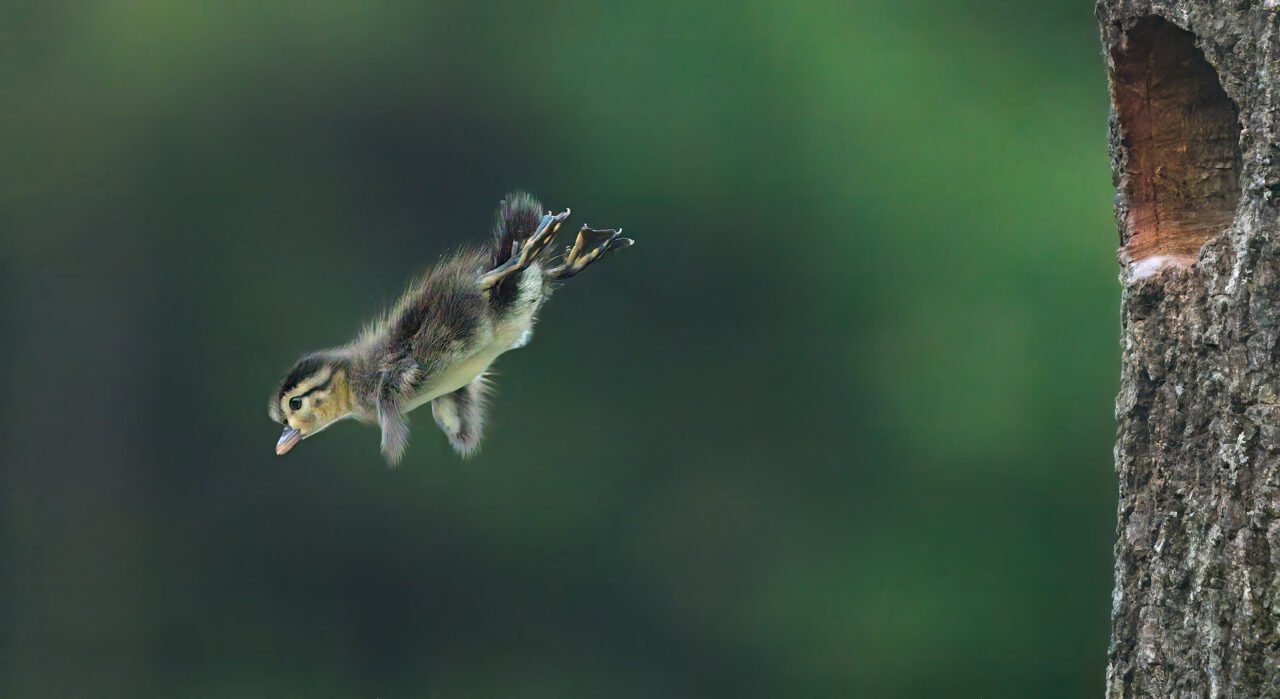
I’ll describe below the typical events one might witness on jump day, but first a disclaimer: I would not recommend this type of photography unless one is quite knowledgeable about wood duck breeding behavior and the recommended methods of monitoring wood duck nest boxes. I hope that the last thing one would want to do is to cause the abandonment of a nest or the premature departure of ducklings when the mother hen is not present–as ducklings are quite vulnerable at this time. I will list a number of references at the end of this article for those interested in learning more about wood ducks. At a minimum, you should read my recommended references prior to attempting this type of photography. I also recommend volunteering to help monitor nest boxes at a refuge or even place and monitor nest boxes.
I am also in the process of writing an ebook entitled Understanding Wood Ducks: A Comprehensive Guide for Observation and Photography. In it I will describe the pertinent knowledge I have gained from numerous books, journal articles, unpublished master’s theses as well my own personal experience. Update December 2023: I have currently written 8000 words for the ebook. This will be a long-term project, as I intend to include video of wood duck behavior as well as audio of calls, etc..
Background Information: Wood Duck hens do not place any nest material in nests prior to egg-laying, but there is usually some debris present in the nest cavities. A hen will initially make a slight scrape or depression in this material. One to several days later, she will begin to lay eggs. Later during egg-laying, usually between the fourth and tenth day, the hen will begin to pluck down from her breast to provide material to help keep the eggs warm.
Wood Duck hens lay one egg a day in the early morning, usually before 9:00 a.m. (I never check a nest box in the morning as I do not want to disturb a hen in the egg-laying process). The male usually accompanies the hen to the nest box and remains in the area while the hen is laying an egg. She can spend anywhere between just a few minutes to almost four hours in the nest at this time. The average duration is just under 2 hours. Normal clutch sizes can vary between eight and 15 eggs with 12 being about average. (In my 15 years of monitoring nest boxes I have seldom seen less than 10 eggs) Clutch sizes larger than 15 are generally considered to be “dump nests” (see below). Egg size can vary within a clutch. Larger eggs will produce young of larger size with greater potential for survivability.
Prior to incubation the hen covers the eggs when she departs the nest. If an uncovered nest is observed, either the hen was startled off the nest or it is a “dump nest.” A dump nest is a nest site that is used by two or more hens to lay eggs. Hens that are unable to locate suitable nest cavities will lay eggs in the nest of another hen. Dump nests occur much more commonly with nest boxes than natural cavities since nest boxes are often placed close to one another. A dump nest generally will contain more eggs than a typical clutch from a single hen, often 20-30 or more. Sometimes a hen will manage to ward off other hen intruders and successfully incubate a dump nest, but at other times the nest will be abandoned. With a large dump nest the hen often cannot effectively incubate all the eggs and many will not hatch.
The hen begins incubation once all the eggs are laid. The male-female pair bond dissolves sometime during the incubation period. It is rare for the mate to be present when the ducklings depart the nest. On only one occasion have I witnessed a male with the female when she called the ducklings from a nest.
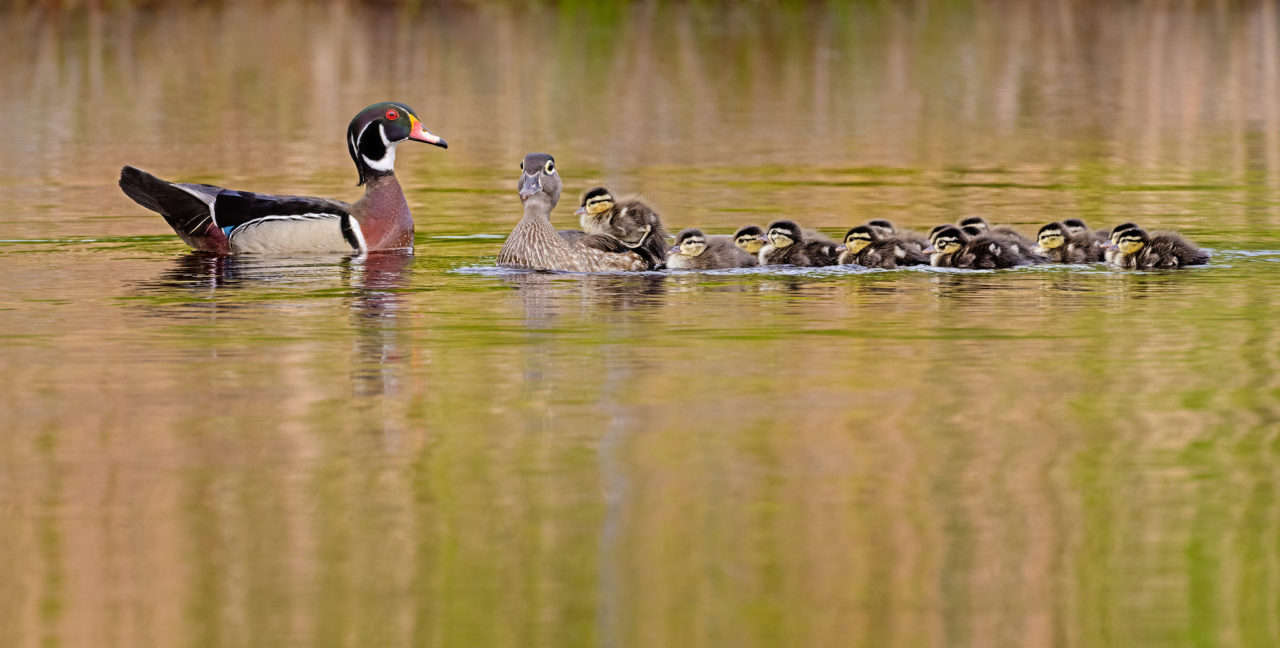
During incubation the hen will make one or two rest or recess flights during the day to feed, once in the early morning and often again in the late afternoon. Average time off the nest at each departure is 40 minutes to an hour. The amount of time off the nest is related to ambient temperatures. On very hot days, hens may actually spend several hours off the nest in the afternoons. Morning recess flights are often quite early, up to an hour before sunrise. The hen will return before other hens make their egg-laying visits, and thus be present to deter any dump nesting in her nest. On several occasions I have witnessed other hens enter nest boxes occupied by incubating females. The ensuing struggles were violent enough to shake the nest boxes. One of the hens is eventually ejected. Incubation lasts about 30 days.
Hatch Day: About 48 hours before hatching, the hen will begin to softly call while in the nest box. This “maternal call” has been described as a soft, low-pitched “kuk”, and is initially given at a rate of about one note per five seconds. It increases to a rate of about four notes per second a couple of hours before the eggs hatch. This maternal calling is a form of auditory imprinting, allowing the duckling embryos to recognize the sound of their mother’s voice. The increased rate of the calling entices the ducklings to begin concerted, synchronized hatching efforts, so that the ducklings all hatch at approximately the same time. The ducklings within the eggs will also begin to make clicking calls during hatching efforts. These calls, along with the scratching and cracking sound of egg shells, are thought to further stimulate ducklings to increase their hatching efforts.
Ducklings have a hard calcareous “egg tooth” at the tip of their bill. The egg tooth allows the duckling to crack through the egg shell. Rotating within the egg, the duckling cuts around the circumference of the egg, about a third of the way down from the large end of the egg. The egg tooth is shed within a day or two of hatching. All the ducklings generally hatch within an hour or two, but it may sometimes take up to four to six hours. Hatching generally occurs in the afternoon. It is thought that the earliest hatchers are the strongest ducklings and have the best chances for survival. Once extricated from the egg, the duckling is wet and exhausted. It only weighs about 0.9 oz at this time. It rests; the feathers become dry and fluffy within a couple of hours. The hen broods the ducklings overnight and nest departure occurs the next morning.
It is not uncommon for one or more eggs to fail to hatch. Dump nests may be completely abandoned with no hatched eggs. Those that are successfully incubated will have larger numbers of unhatched eggs. For example, one of my monitored nests this year only hatched eight of 26 eggs.
If disturbed at the nest while young are present, the hen will exhibit the broken wing display. The hen will fly down and flap about on the water or ground as if it has a broken wing. This display has occurred in every instance where I have checked a nest box with hatched young. The hen will leave the nest at the sound of my approach or when I tap on the side of the nest box (which I always do before opening a nest box).
Jump Day: The hen leaves the nest early the morning after the ducklings hatch, just as she did during incubation, to feed and possibly explore a departure route for the ducklings. She returns to the nest an hour or so later and broods the young for a while. The length of this brooding period appears to be at least partially dependent upon ambient temperature.
Eventually she will appear at the nest entrance. She may remain at the entrance for several minutes, checking the area for any sign of danger. If not satisfied that it is safe, she will retreat back into the nest. The presence of hawks or other predators and any unusual sounds such as barking dogs (or the sound of a camera shutter) will cause a retreat back into the nest. The hen often makes appearances at the nest entrance a number of times, for varying lengths of time, before leaving the nest. I’ve had a hen reappear at the nest entrance up to eight times before leaving. Once I had a hen remain at the nest entrance for 30 minutes before departure.
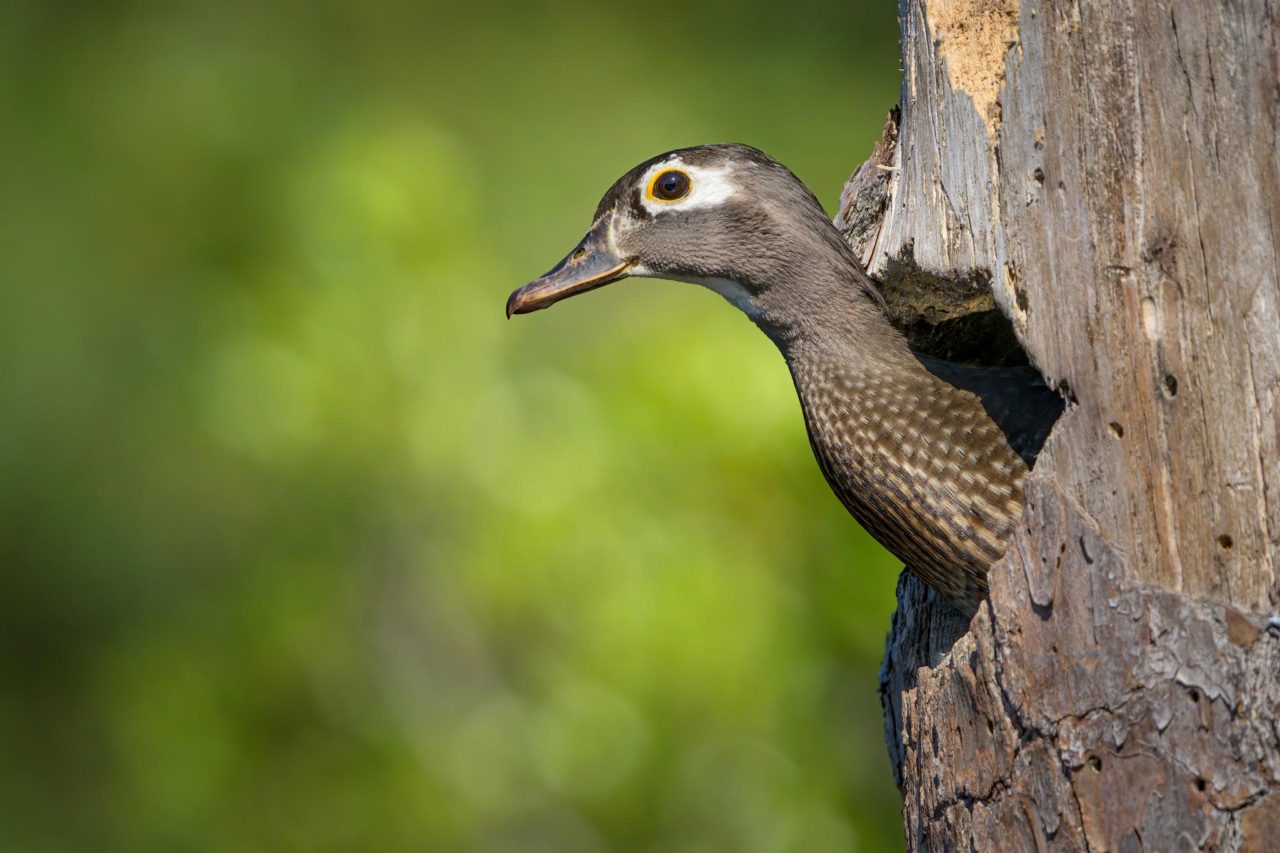
When the hen decides it is safe, she will drop or fly to the water or ground below and call the ducklings. She uses the maternal call (louder and at a rate of 9-10 notes per second) to entice the ducklings to leave. Actual departure time can vary greatly. In my 15 witnessed jump days, the departure time has varied between 7:47 a.m. to 12:10 p.m–10 of 15 departures were before 10:00 a.m. Hester and Dermid report waiting in a blind until 4:00 p.m. for ducklings to depart. Personally I would recommend aborting the photography attempt if the ducklings have not departed by early afternoon. Removing yourself from the scene at this time would still allow enough daylight for the ducklings to depart, feed and find cover for the night. Although I have witnessed 15 departures, I did abort one other attempt when it appeared that the hen was not accepting my presence. I removed the blind and myself from the scene. I returned at the end of the day to find that the ducklings had indeed left the nest box.
The ducklings respond to the calls by leaping toward the nest entrance. The sharp claws on their feet will catch on the rough interior wall of the nest. A lunge upward will result in a grasp higher on the wall. Eventually the duckling will reach the top and leap from the nest entrance. It is often a frantic time, with the ducklings leaping, colliding, and dislodging one another from the walls. It is not uncommon to see two or more ducklings at the entrance at the same time. Typically the ducklings will respond fairly quickly to the maternal call and depart from nest within several minutes, but it can vary significantly. In my observations, response time from initial calling by hen to first duckling departure has varied from a few seconds to 14 minutes. Actual departure time from first to last duckling has varied from 17 seconds to 34 minutes (10 of 15 jump days–within five minutes, eight of 15 within two minutes).
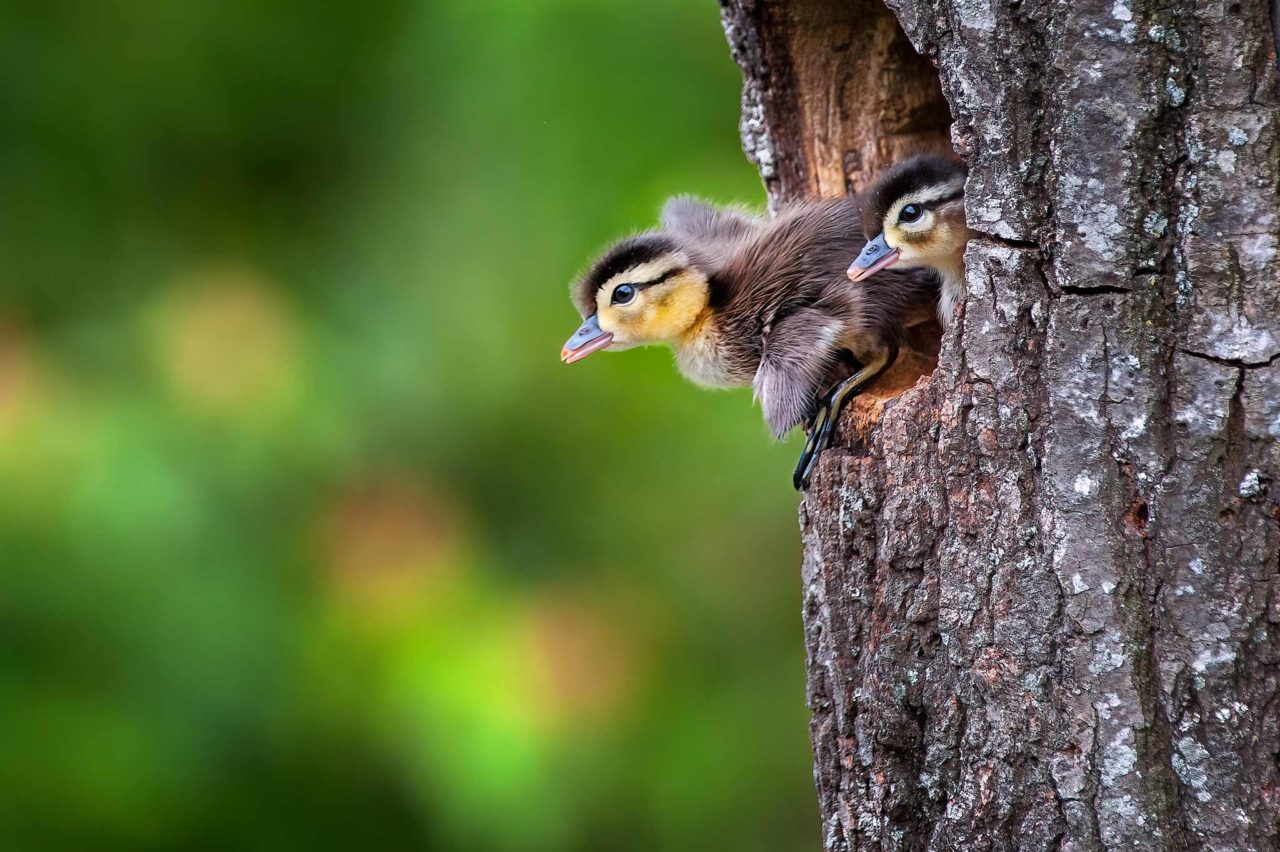
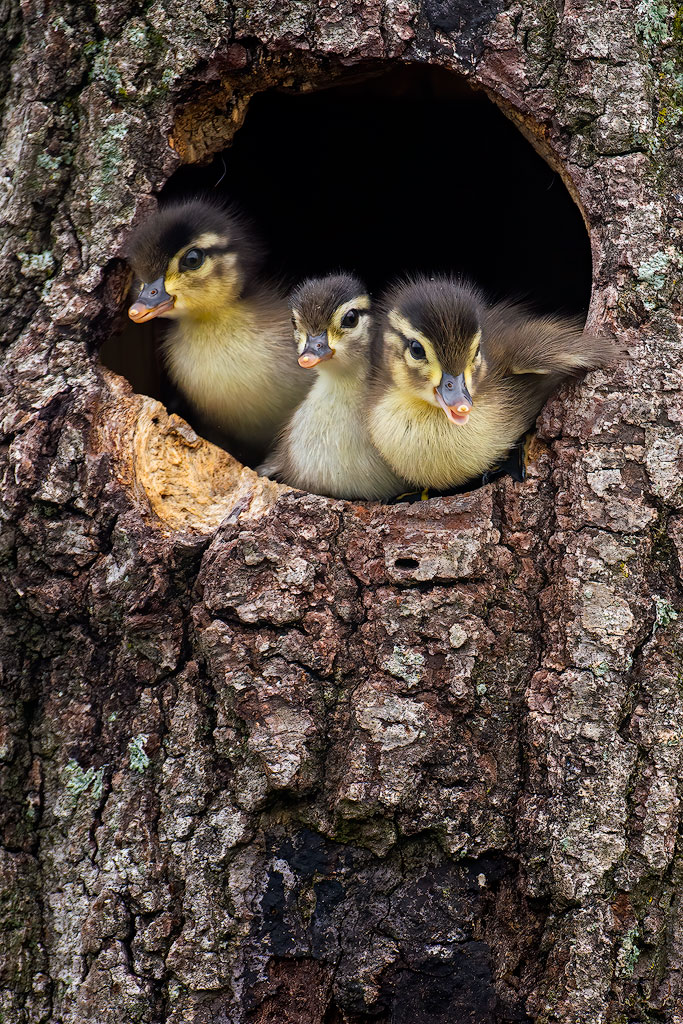
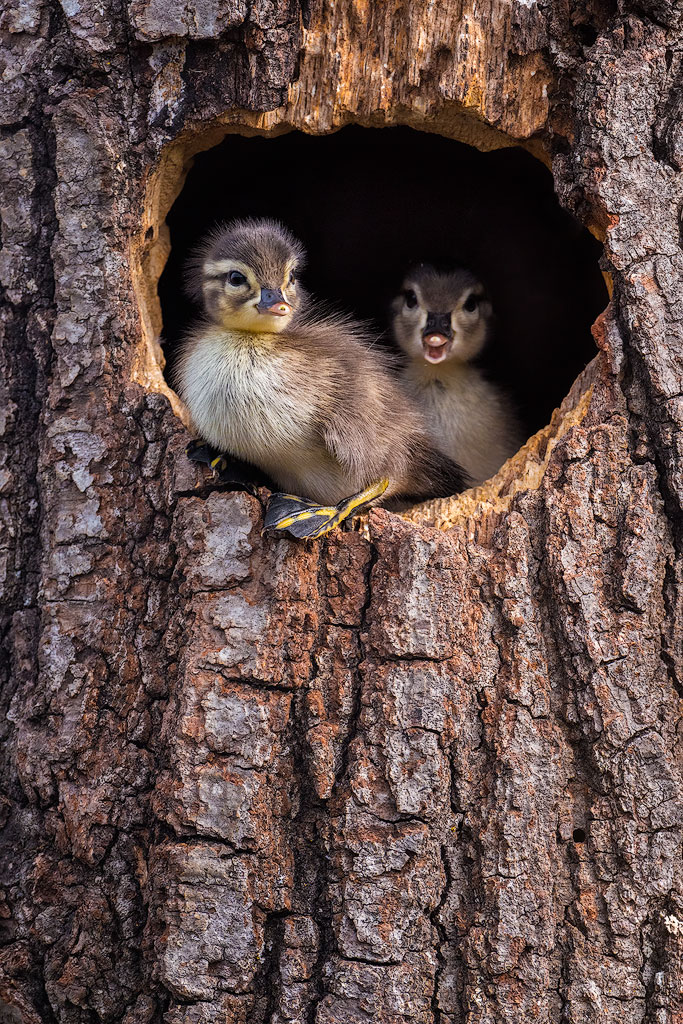
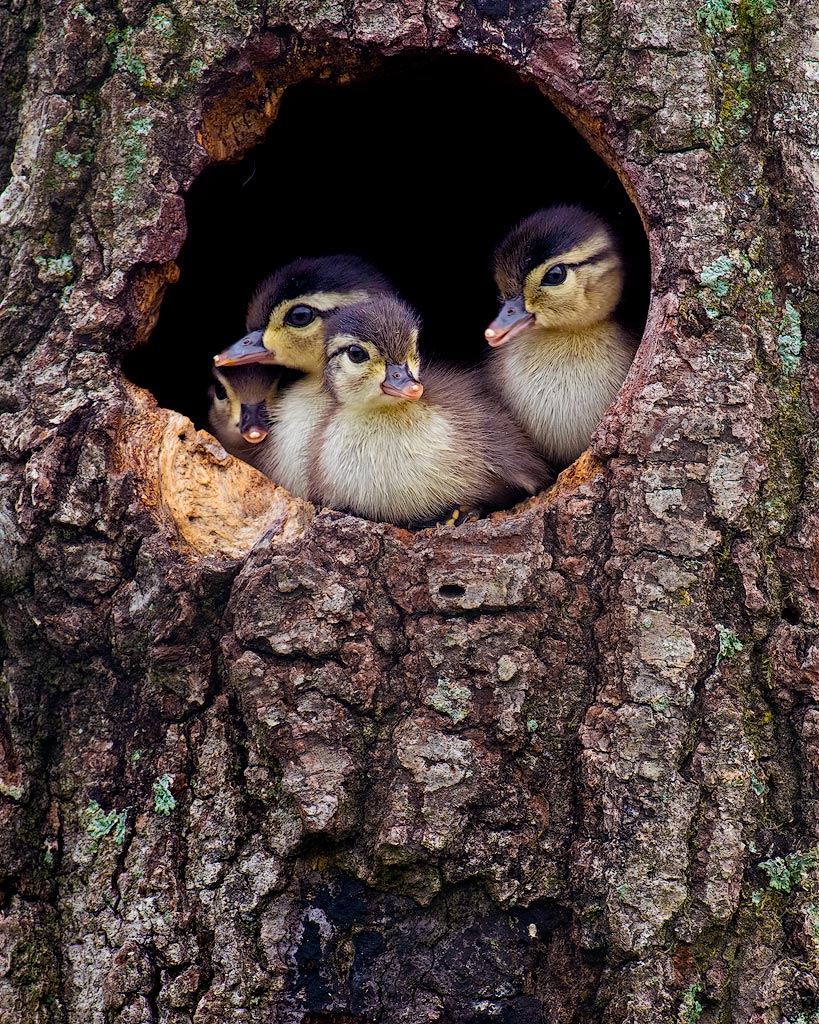
Sometimes late-hatching and weaker ducklings are unable to exit the nest cavity. In nest box studies, about three percent of hatchlings remain in the nest and die, too weak to exit.
Photo Tips
At a minimum please read the first reference listed in the References section. If possible read the first two. The second reference has some excellent articles on methods of monitoring nest boxes.
Do not check the nest box the morning of jump day. If the young were present the afternoon before, they will be there the next morning. I have never had ducklings depart the same day they hatched. You do not want to disturb the hen if she is on the nest that morning. Nor do you want to flush the ducklings off the nest if the hen is not present (i.e. she has already departed for her morning feeding).
Use your longest telephoto lens.
Use of a blind is a must, unless you are somehow working with remarkably tame wood ducks. I have been photographing the ducks of my pond for eleven years. These ducks will still flee the pond if they catch any sight of me.
The blind needs to be opaque, with no stray light entering any windows. It is imperative to avoid any backlighting or direct lighting that may illuminate your movements .
Set up your blind the afternoon prior to jump day. You will need to be in your blind before dawn on jump day.
Lens movement will probably cause the hen to retreat back into the nest. Pre-position and pre-focus your lens on the nest entrance.
Unless you have a very quiet shutter avoid taking images while the hen is at the entrance. The use of a mirrorless camera will be advantageous.
Use shutter speeds of 1/3200 to 1/4000 of a second. The ducklings can leap off the nest box with surprising speed. Many of my early images were ruined by motion blur because they were taken with shutter speeds of 1/2000 to 1/2500 second. This is particularly important if you want to capture images with the ducklings large in the frame. A more magnified image will more readily exhibit motion blur.
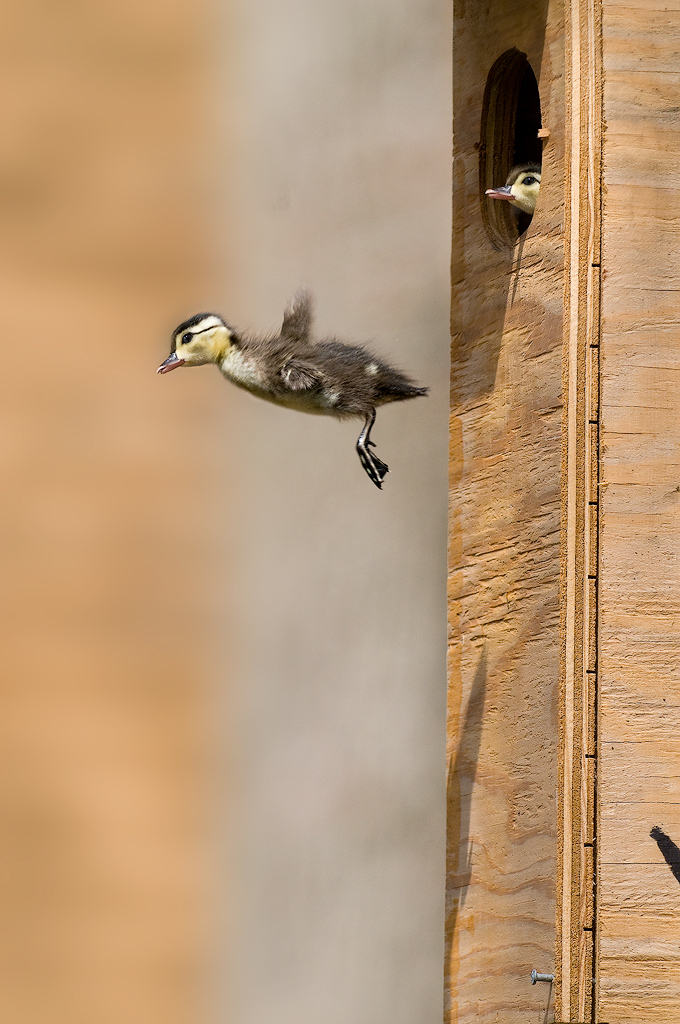
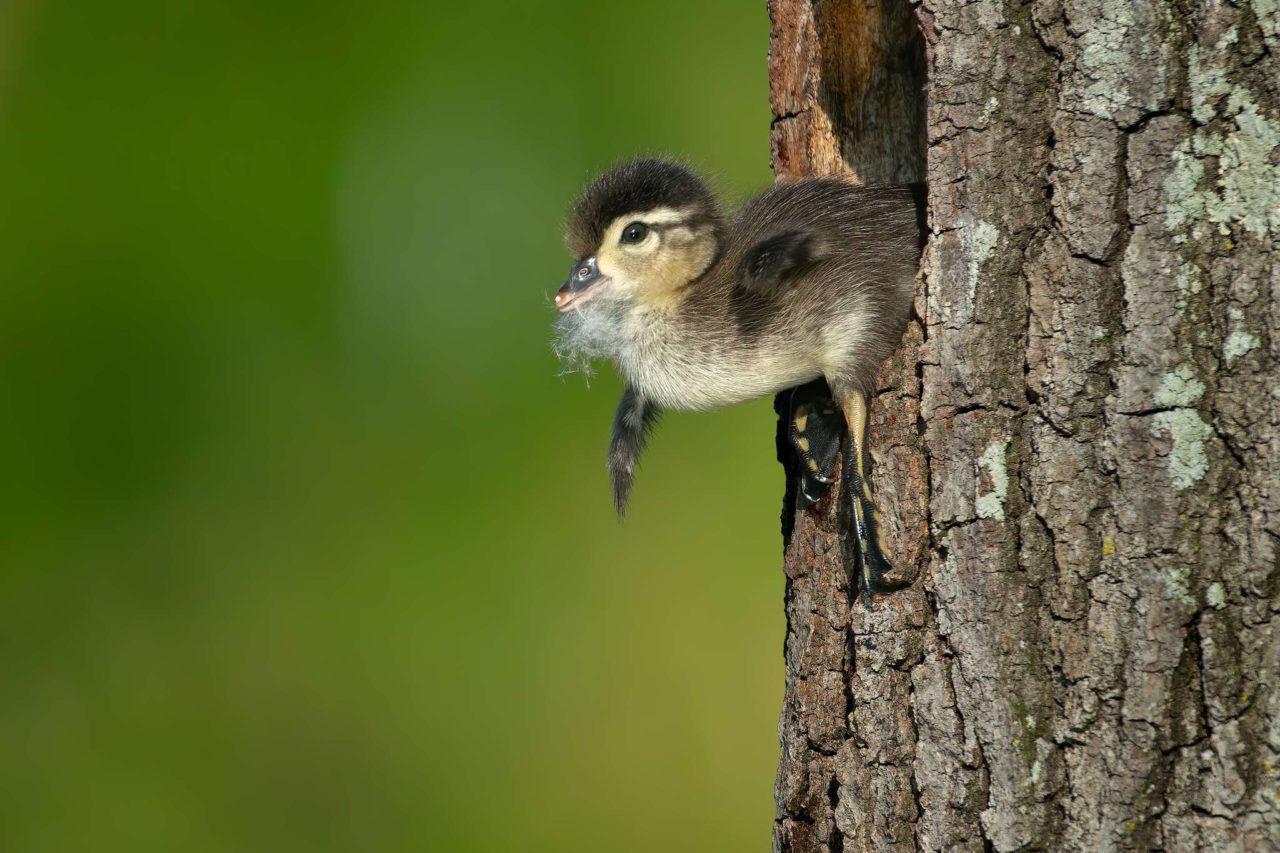
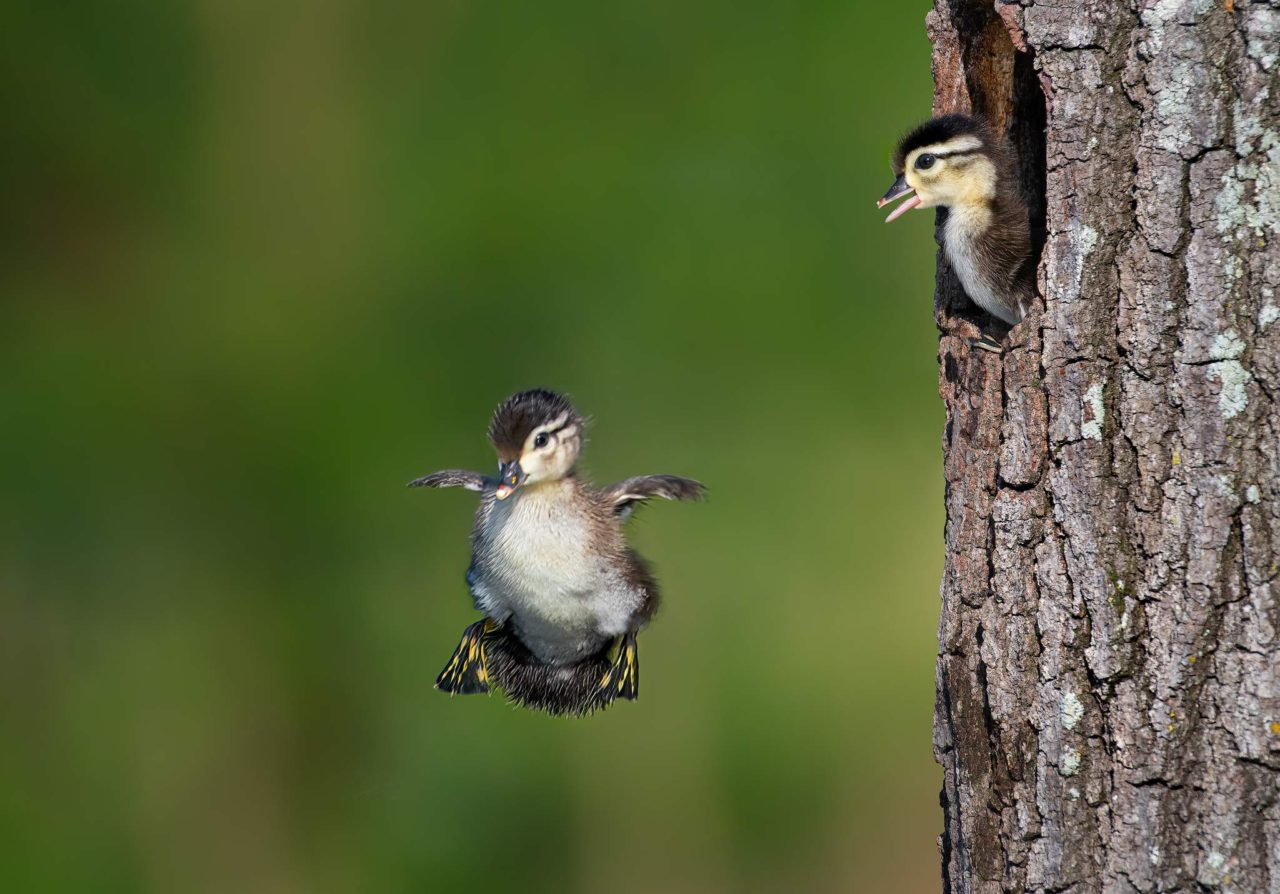
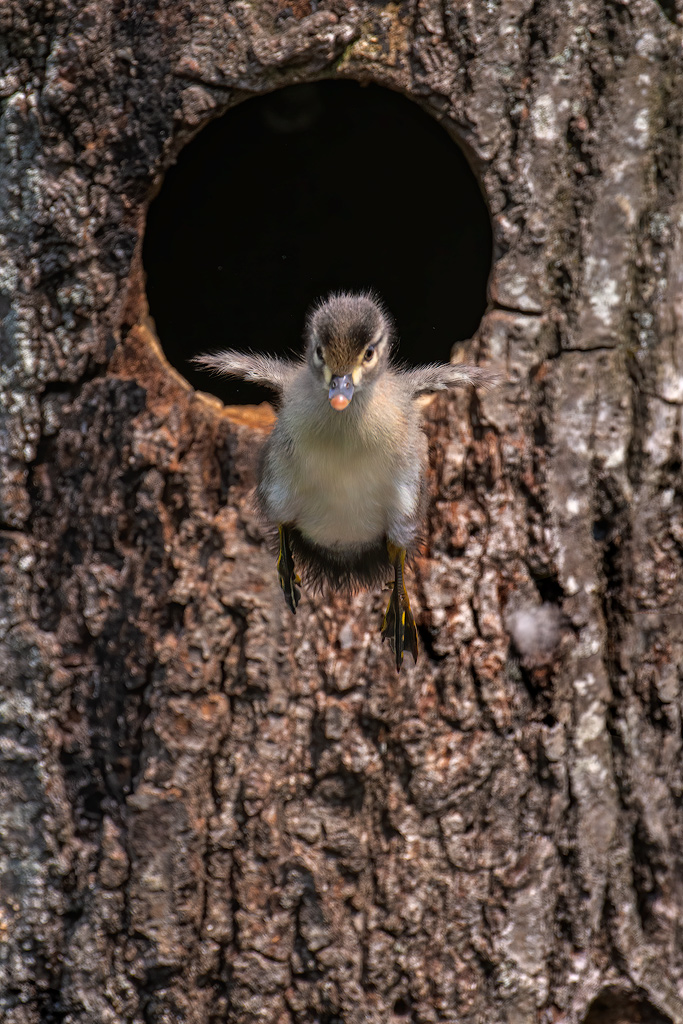
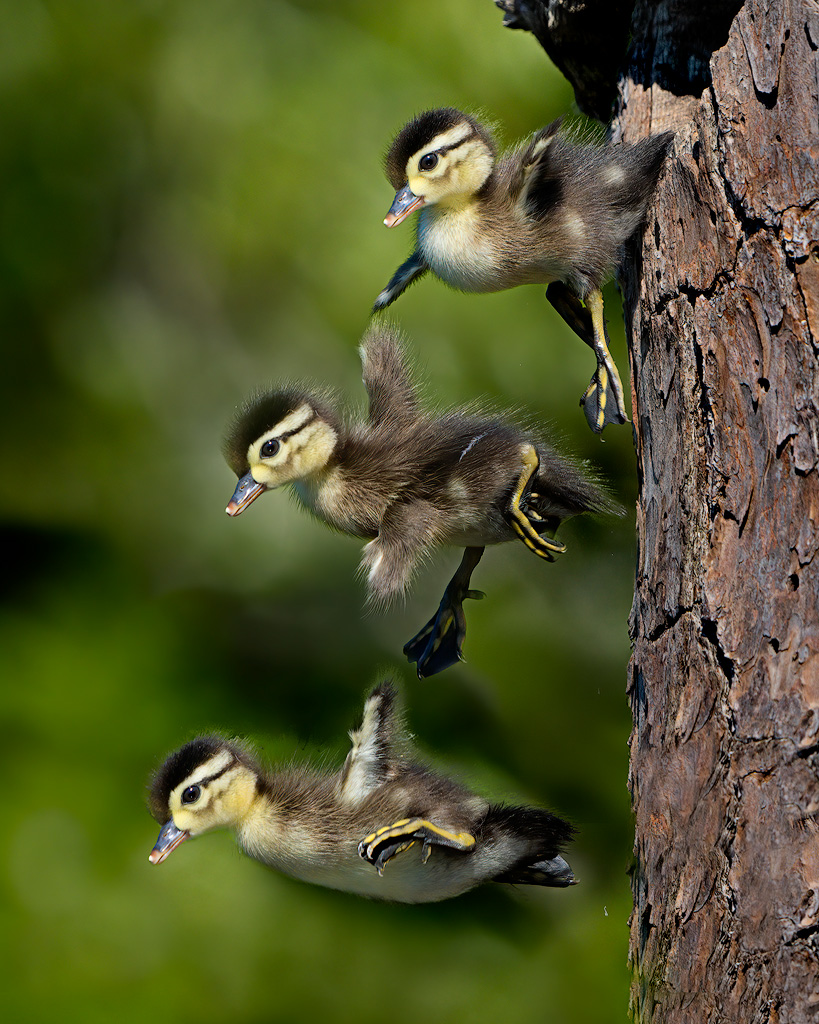
Composite Image Of Single Wood Duck Leap
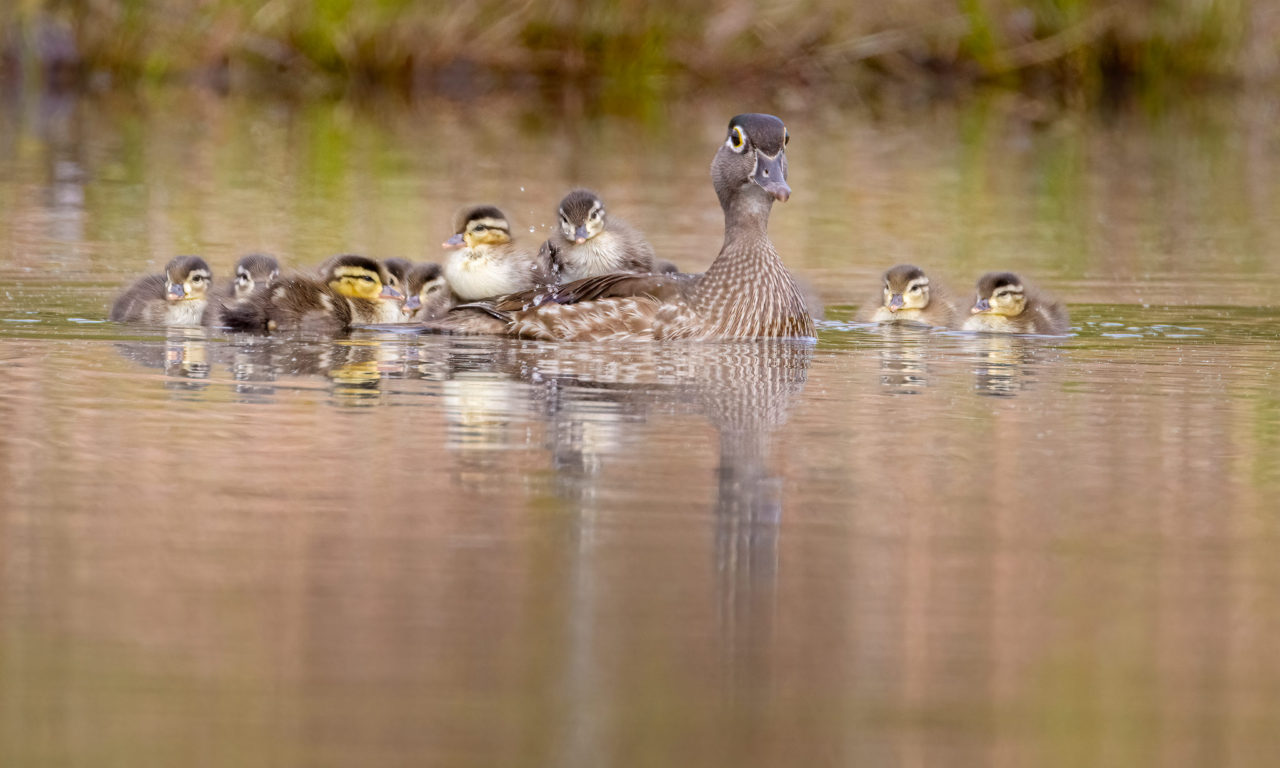
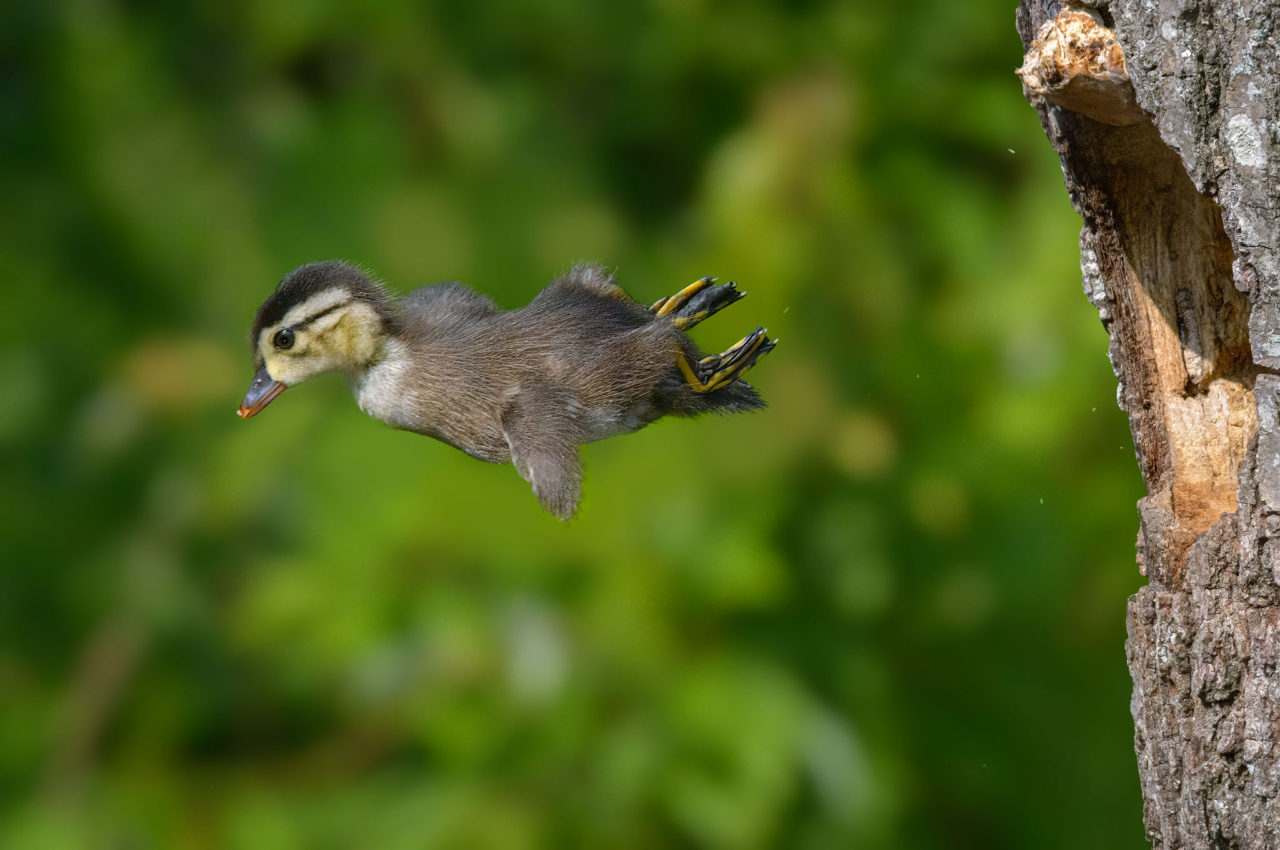
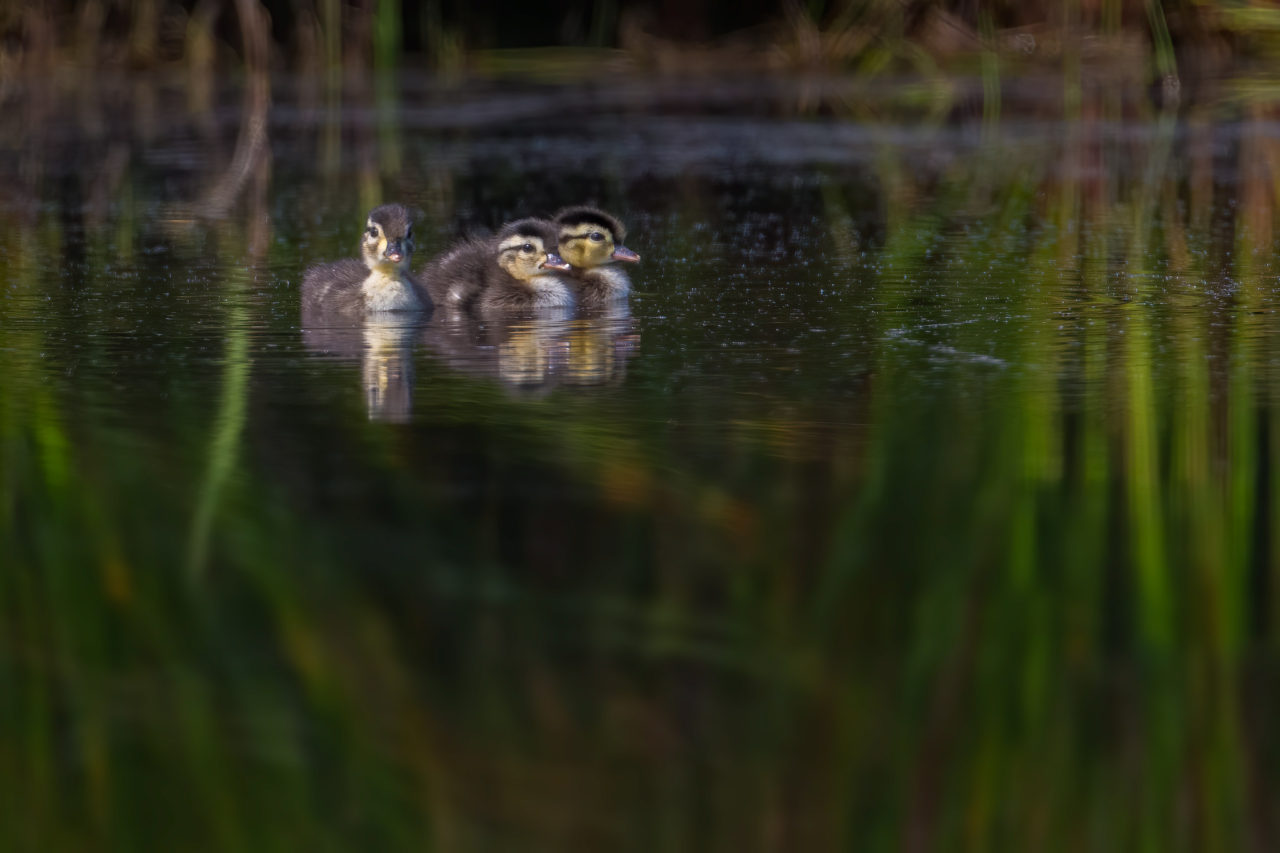
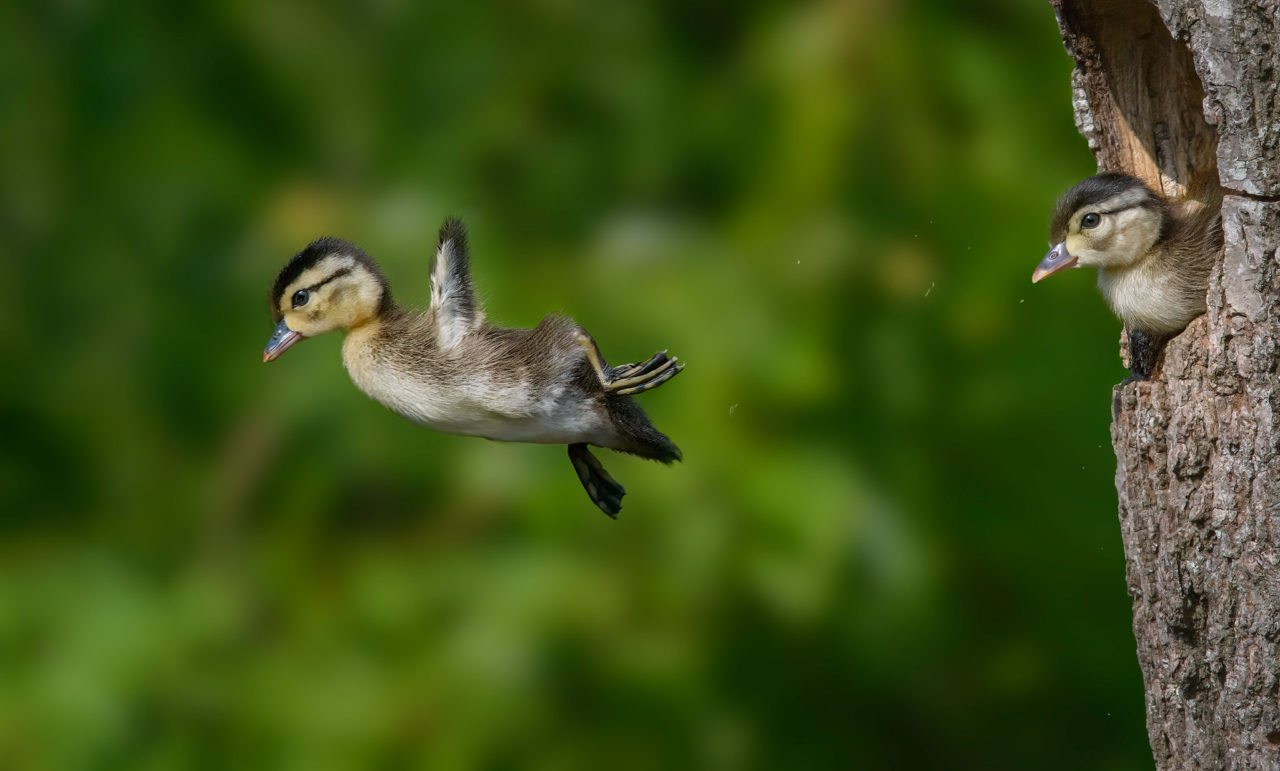
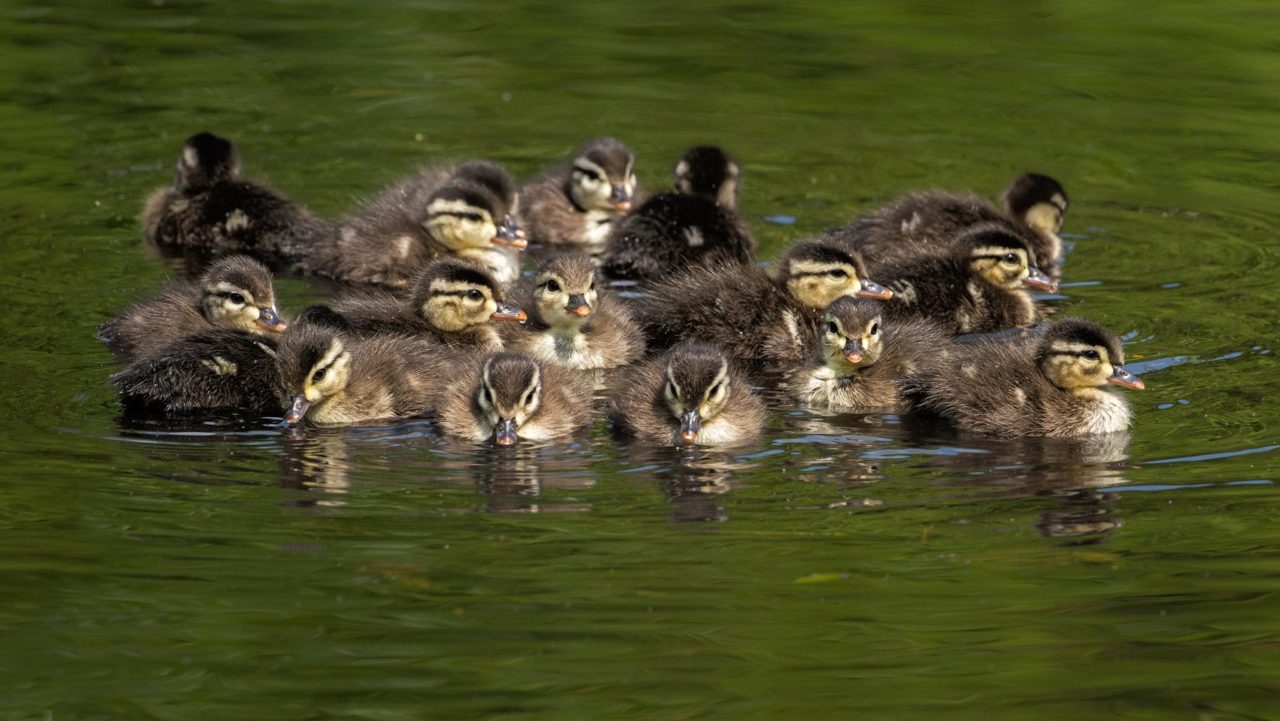

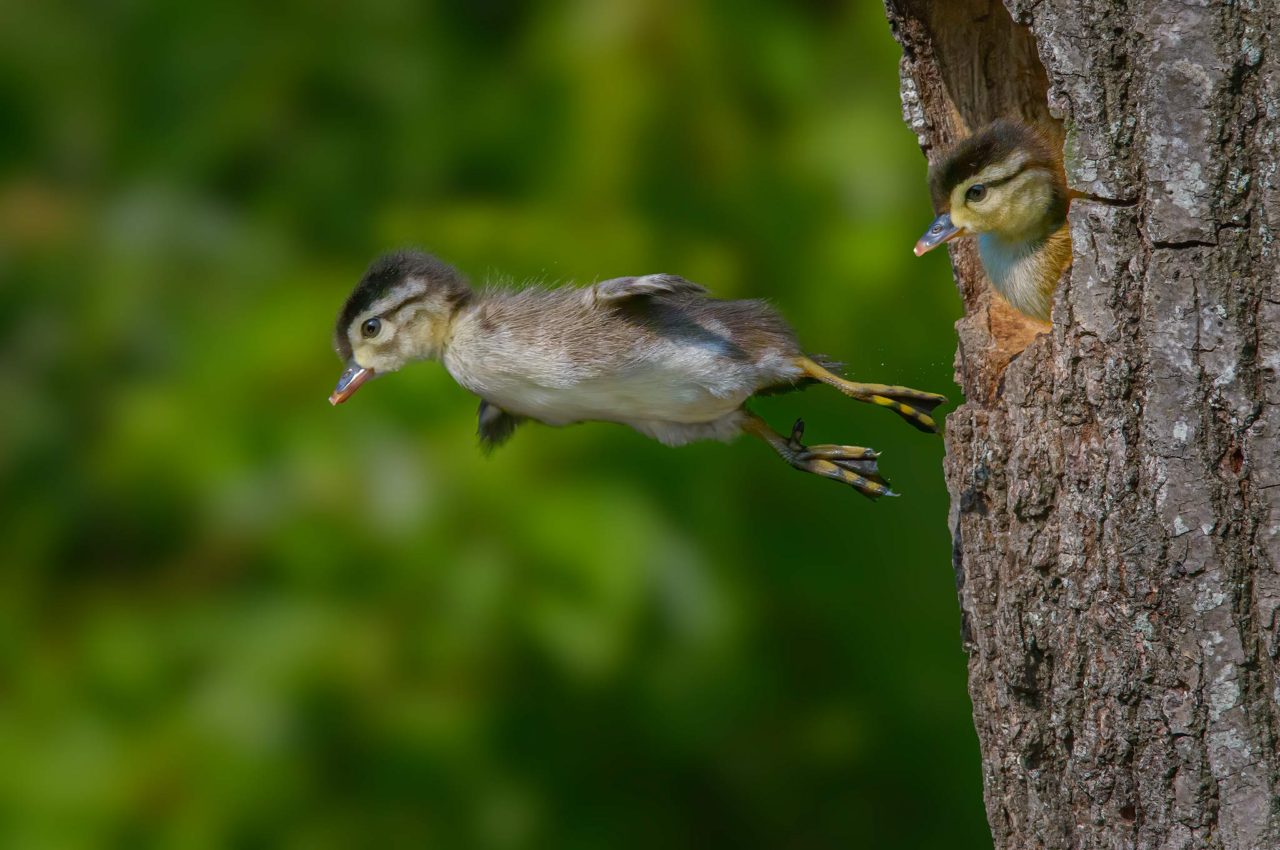
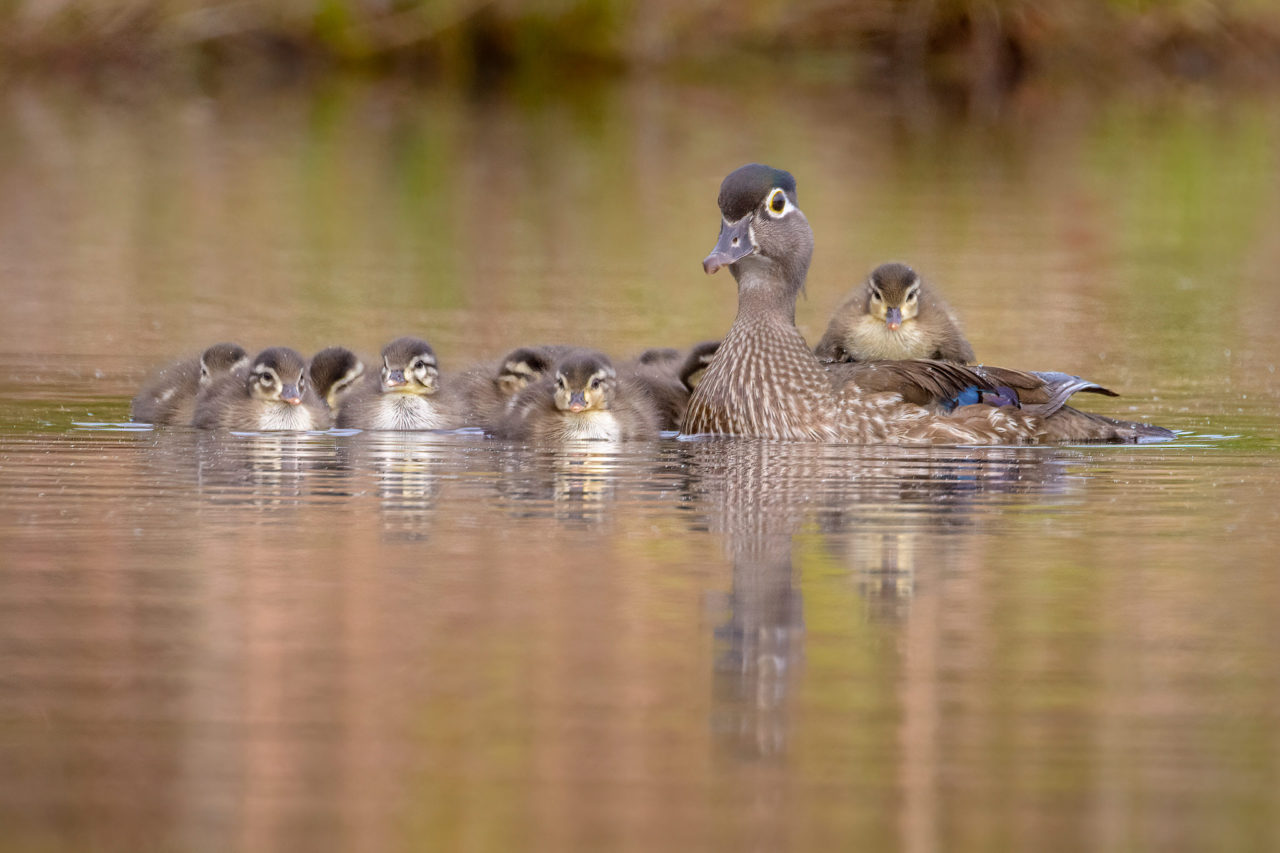
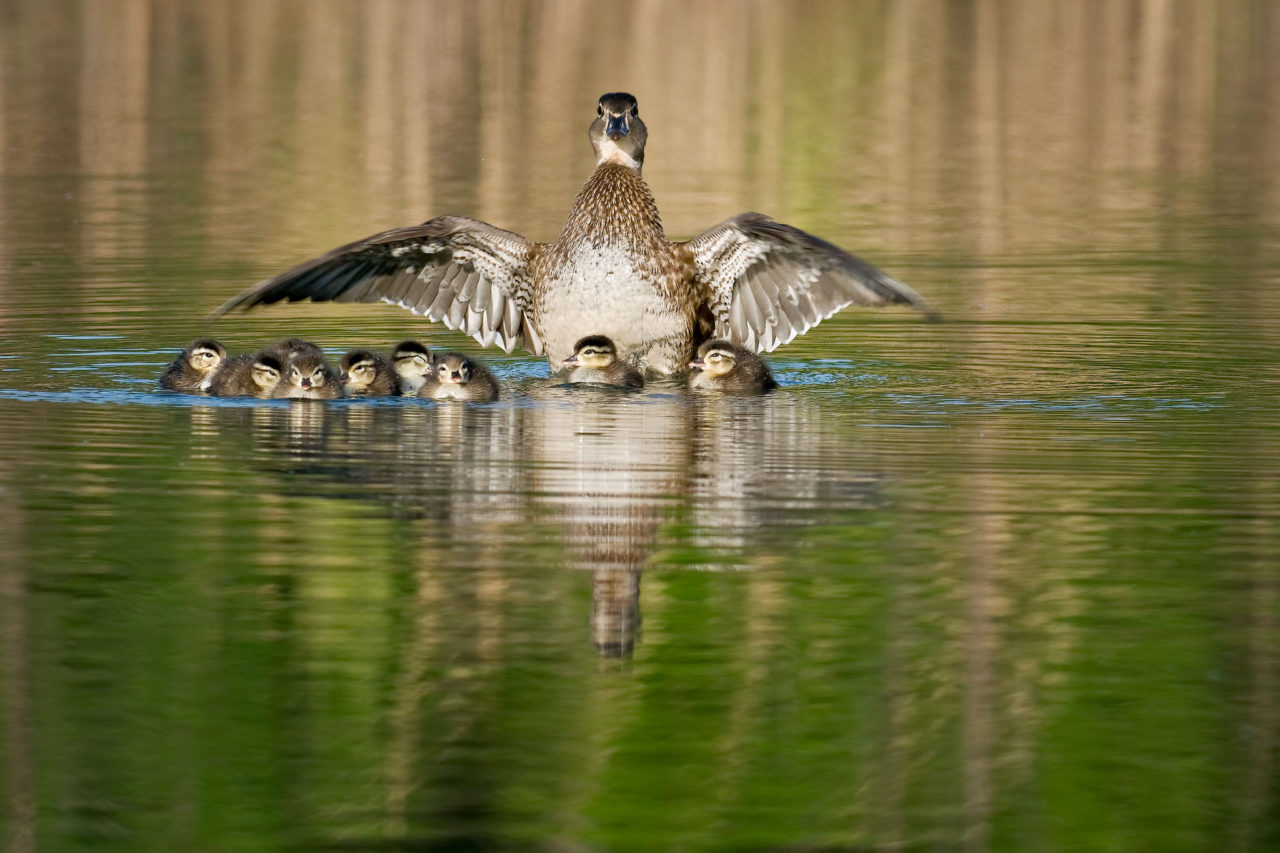
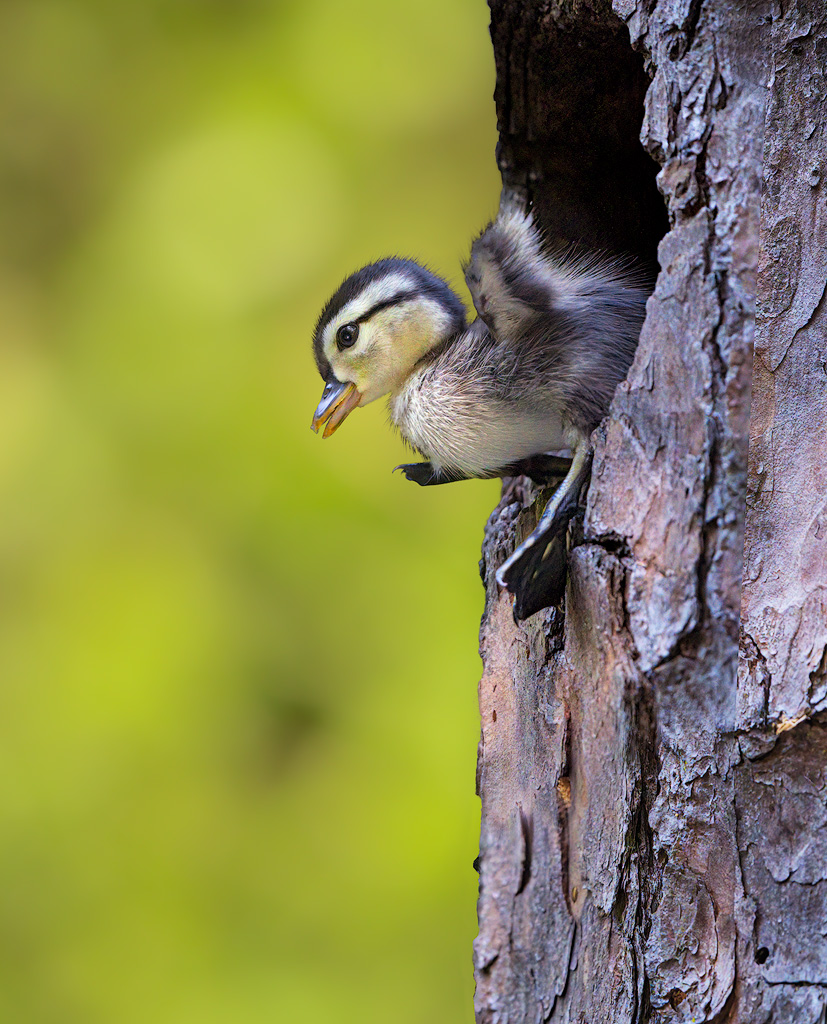
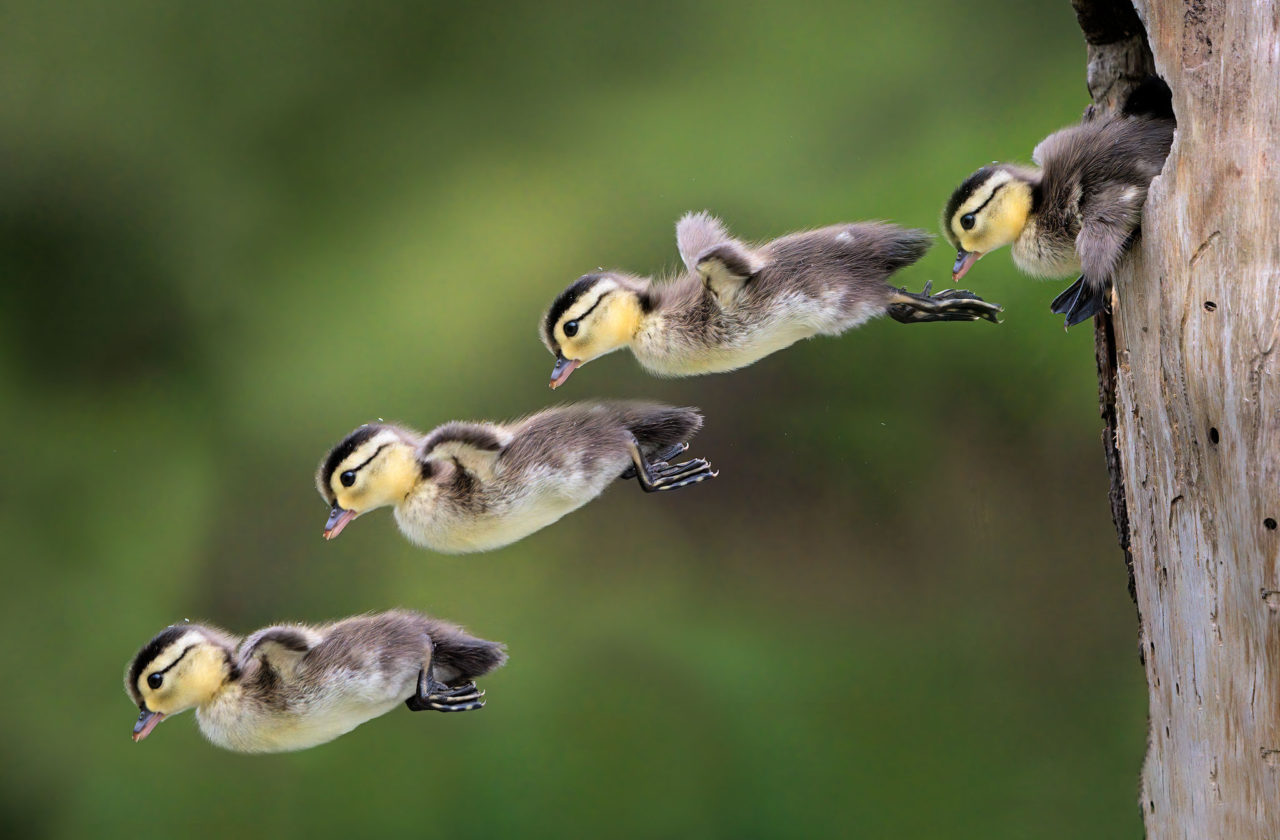
Composite image of Single Wood Duck Jumping
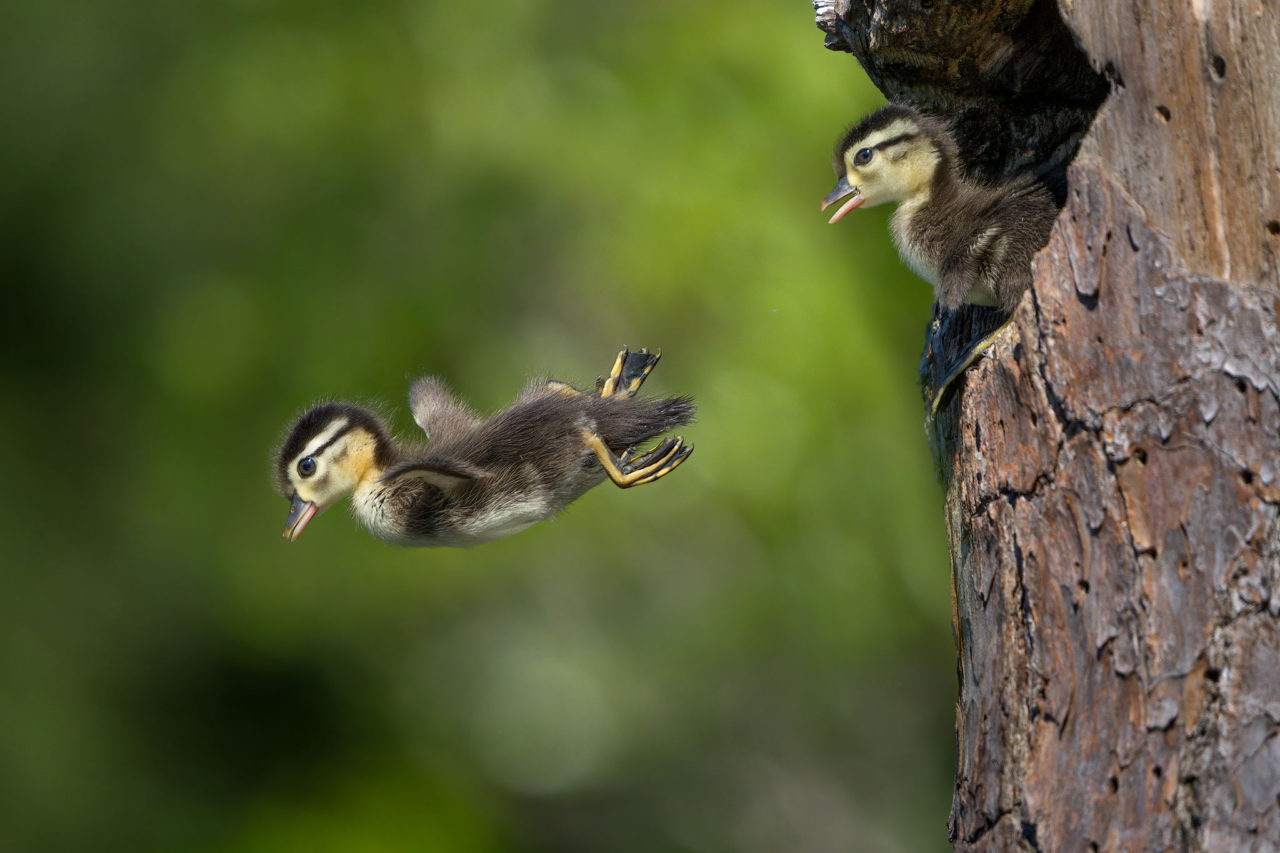
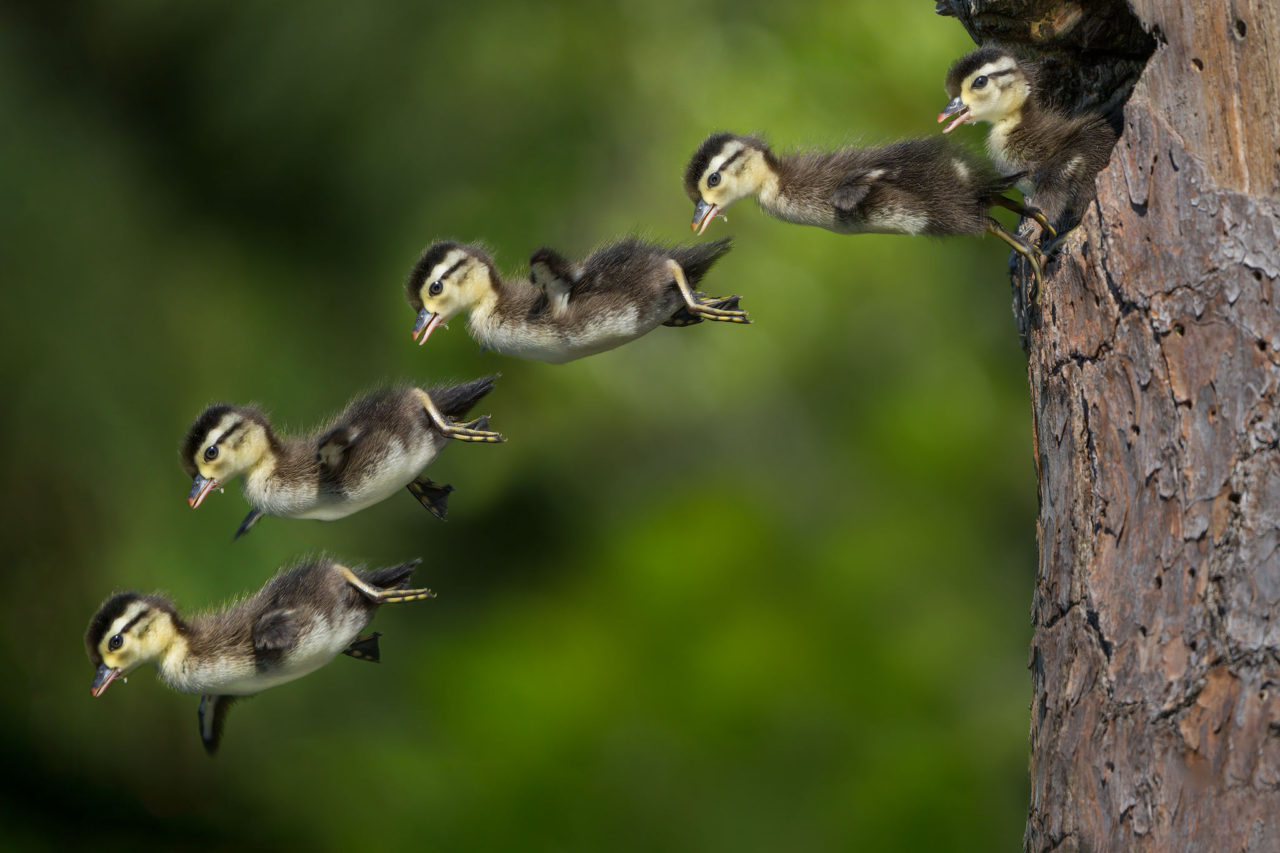
Composite Image of a Single Wood Duck Leap
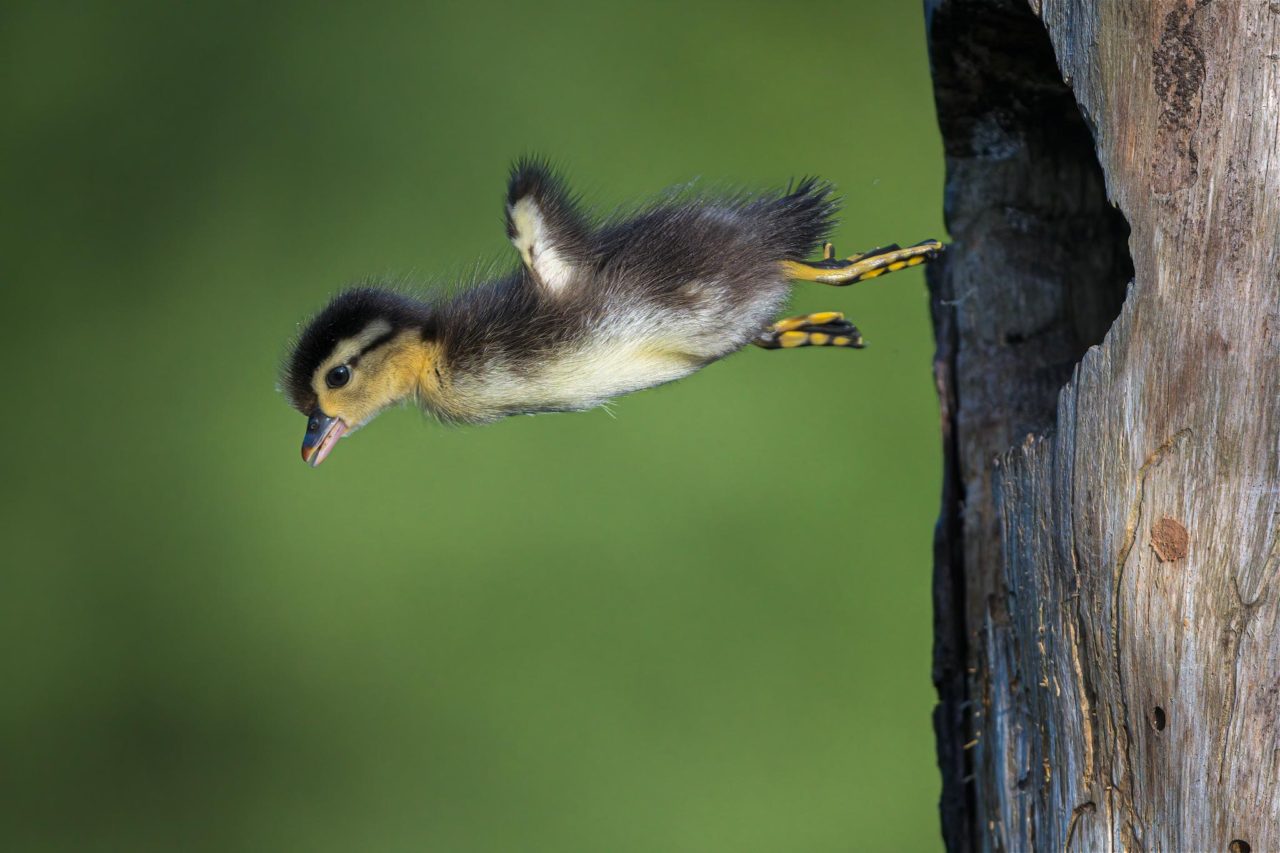
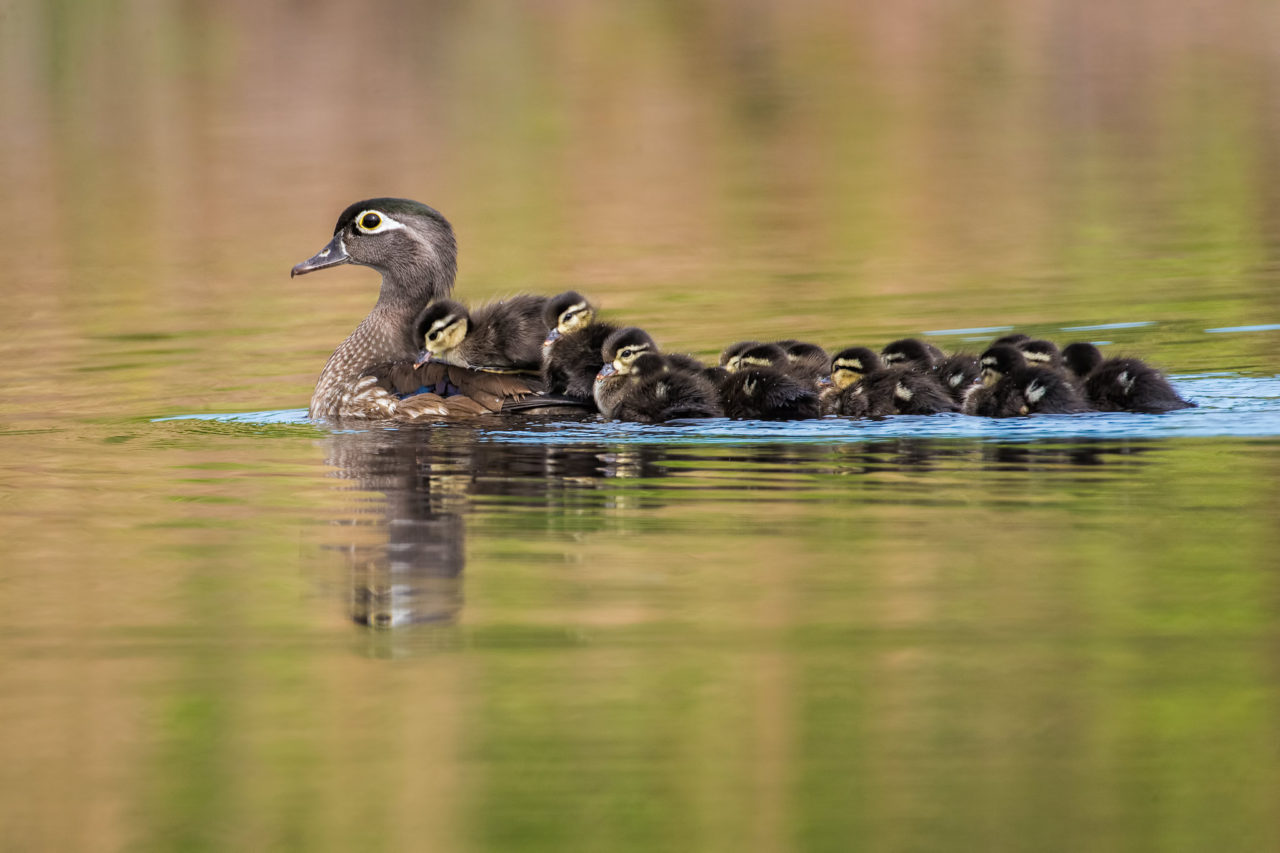
References
Ecology and Management of the Wood Duck. Frank Bellrose and Daniel Holm, 1994
The 1988 North American Wood Duck Symposium: Selected Papers. Leigh Fredrickson, et. al., editors, 1990.
The World of the Wood Duck. F. Eugene Hester and Jack Dermid, 1973.
With Wings Extended: a Leap into the Wood Duck’s World. Greg Hoch, 2020.
The Wood Duck in Massachusetts. David Grice and John P. Rogers, 1965,
The Unique Wood Duck. Richard McCabe, 1993.
Wood Duck Management and Research: A Symposium. James B. Trefethen, editor., 1966.
